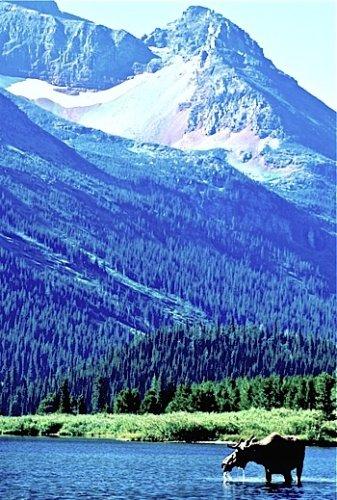Glacier National Park is rich in wildlife -- ever been to Logan Pass? -- and most of it is readily visible. From bears to moose to mountain goats, the park is a haven for wildlife. Park officials now are proposing to make it easier to find that wildlife in the Many Glacier area.
Under that proposal, park officials would improve pullouts along roads in Many Glacier and offer more educational materials. The proposal, the subject of an environmental assessment, will be the focus of an open house on October 6 from 5 p.m. - 7 p.m. in the St. Mary Visitor Center. If you can't make that meeting, but still want to comment, you have until October 16 to provide your input.
According to a park release, the Many Glacier Wildlife Viewing Plan "is focused on providing visitors with exceptional wildlife viewing opportunities in one of the most popular and memorable places in the park while protecting wildlife and their travel routes across the Many Glacier Road."
Under the preferred alternative, there would be "increased educational opportunities, development of a new pullout on the Many Glacier Road, enlarging and or improving existing pullouts in popular wildlife viewing areas, formalizing some undesignated pullouts and removing some pullouts that are located too close to places where wildlife frequently cross the road."
A formal wildlife viewing area would be constructed in the Swiftcurrent Motor Inn parking lot and orientation to the Iceberg Lake/Ptarmigan Trail would be improved. The plan also calls for a short trail into the meadow at Apikuni Flat, formalizing and surfacing the foot and bicycle path between the Many Glacier Hotel “T” intersection and Swiftcurrent parking lot and reducing the speed limit along the road from 45 to 35 miles per hour.
The proposed formal wildlife viewing area in the Swiftcurrent Parking Lot is one of the legacy projects being funded by the Glacier National Park Fund in honor of the park's centennial.
According to the EA, the preferred alternative "would have short and long-term beneficial impacts to wildlife, threatened and endangered species, and species of concern due to reduced risk of displacement, disturbance, collisions with motor vehicles, excessive habituation, food conditioning, and conflict with people."
You can find more details on the proposal, and a form for commenting, at this site.




Comments
I'm looking forward to our visit of Glacier NP next summer. Going to be there in late July and we have three nights booked at the Many Glacier area. Hoping to see lots of wildlife there!
I hiked up onto a big horn sheep there last summer. He was grazing about 20 yards from me, gave me the once over, then continued lunch until another hiker came along and spooked him. Also saw mountain goats, but, alas, no bear.